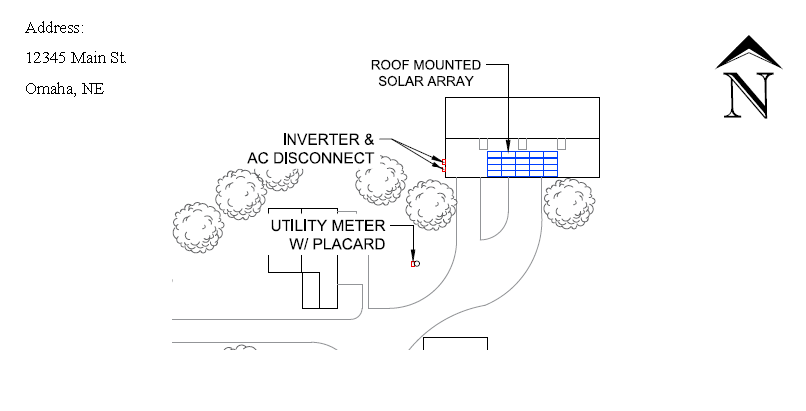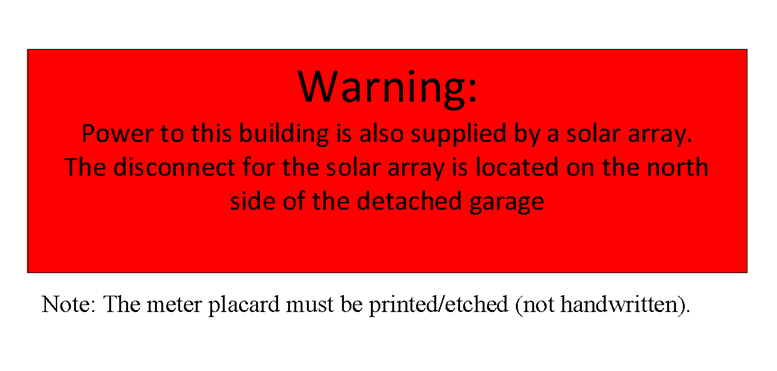Is my roof right for solar?
OPPD has a Solar Calculator available to help you determine if your home is a good fit and to provide a cost estimate. Solar panels can be installed on most roofs. Here are important factors in determining the cost, size and efficiency of your installation:
- Direction: South-facing roofs are the most productive for solar, followed by west- and east-facing structures. North-facing roofs often are ruled out due to lack of direct sunlight.
- Shade: Sun should hit your panels for five or more hours a day. It’s a problem if trees or other obstructions block the sun from shining on your roof.
- Roof pitch: The ideal angle for solar panels is 30 degrees, but they can be installed on roofs ranging from zero to 45 degrees. Tilted racks are used to mount solar panels on flat roofs.
- Size: The average amount of contiguous space needed for a residential solar installation is 500 square feet.
- Roof type: Asphalt shingles or corrugated metal are the best surfaces for mounting rooftop solar systems. Installation on slate or tile is more complex and expensive, and wood shingles are sometimes ruled out due to the fire hazard.
- Roof age: If your roof needs to be replaced within the next five years, you should consider doing it before installing solar panels. Removing and reinstalling solar panels will add cost to a roof replacement.
What are the components of a rooftop solar system?
There are many variables when it comes to the actual solar installation, but the main components of a typical system include:
- Solar Photovoltaic (PV) Panels – Solar panels convert energy from the Sun into electricity. The panels are connected to a main string inverter or multiple microinverters.
- Solar Panel Mounting Racks - The mounts that secure the panels to your rooftop. Proper mounting is crucial to prevent roof damage and ensure stability, especially in extreme weather conditions.
- Inverter - Solar panels produce direct current (DC) power but your home uses alternating current (AC) power. An inverter converts the DC power to AC power.
- Net Meter - A specialized electric meter is necessary for a grid-connected system. The net meter is provided by OPPD and will allow you to receive energy from the grid and export surplus energy to OPPD for credit. Click here to learn more about net metering with OPPD.
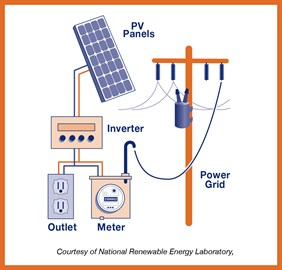
Are there different types of solar panels?
There are three major types of solar panels: monocrystalline, polycrystalline (also known as multi-crystalline), and thin-film.
- Monocrystalline – These panels are the most popular type for residential systems. They have the highest efficiency rating at about 20%, perform well in low-light conditions, and are space efficient and durable. Monocrystalline panels are more expensive than the other options because they are made using high-grade silicon and require a more complex manufacturing process. They usually come with a 25-year warranty.
- Polycrystalline (Multi-crystalline) – These panels have an efficiency rating of about 15% so they require more surface area coverage to get the same production as monocrystalline panels. Polycrystalline panels are cheaper than monocrystalline because they are made using lower-grade silicon and a simpler manufacturing process. They are often used by people looking to go solar on a budget.
- Thin-film - These panels have an efficiency rating of about 11% so they require significantly more surface area coverage to get the same production as monocrystalline panels. Thin-film panels tend to degrade faster and have shorter warranties than monocrystalline and polycrystalline panels.
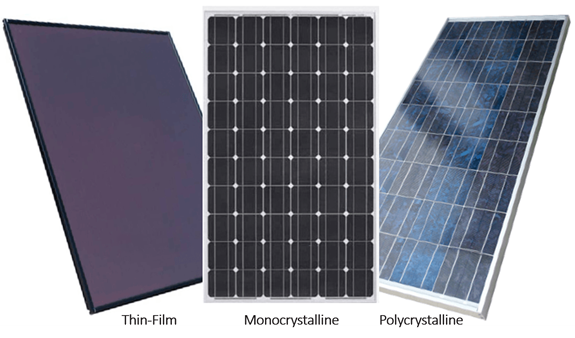
How large should my solar system be?
OPPD has a Solar Calculator available to help determine how large of a system you may need based on a number of factors including:
- How many kilowatt-hours (kWh) you use per year. Click here to learn how to read your bill.
- What percentage of your energy use you want to offset with solar.
- The efficiency rating of the solar panels you’re considering.
The average residential solar system in OPPD is seven kilowatts (7 kW) which translates to approximately 28 high-efficiency solar panels.
What resources are available for information regarding trusted contractors?
OPPD has a list of Solar Trade Allies that are experienced professionals who have been trained by OPPD on the application process, met a list of qualifications, and agreed to standards of conduct. Always get multiple competitive bids before signing a contract.
What questions should I ask solar contractors?
Here are questions to ask a solar installer, according to the American Solar Energy Society.
What solar rebates, tax credits and incentives are available?
- Rebates – OPPD customers who install a qualifying solar system using a Solar Trade Ally may be eligible for a $2,000 rebate.
- Federal Tax Credits – The Inflation Reduction Act of 2022 increased the federal solar tax credit to 30% for qualifying systems installed from 2022-2032. Contact a tax professional to learn how this affects you.
- State Tax Credits - Nebraska does not currently have a state tax credit.
- Net Metering – OPPD offers a net metering program for customers with qualifying systems. Click here to learn more about net metering with OPPD.
- Low Interest Loans – The Nebraska Department of Environment and Energy offers Nebraska Dollar and Energy Savings Loans statewide for qualifying facilities.
Who is eligible for a solar rebate from OPPD?
OPPD customers who install a qualifying solar system using a Solar Trade Ally and whose interconnection application was submitted on or after Jan. 1, 2023 are eligible. See the Terms and Conditions for more information on qualifying systems.
How do I find a Solar Trade Ally?
How do I apply for a solar rebate?
The Trade Ally will apply for the rebate on your behalf. Only customers who use a Solar/Customer-Owned Generation Trade Ally are eligible for the rebate.
What does an OPPD account in good standing mean?
OPPD customers with accounts in good standing are up to date on payments on their account and do not have any outstanding debts with OPPD.
What is a W-9 and why do I have to provide it to get a rebate?
The IRS form W-9 is a request for taxpayer identification number and certification used to identify an individual or business for the purpose of fulfilling tax obligations. Rebates issued as part of this program may be considered taxable income by the IRS.
If applicable, OPPD will issue a 1099 form for the taxable year in which you received the rebate. The 1099 form will be mailed by January 31 of the year following receipt of the rebate to the address on file.
OPPD’s Solar Rebate falls under the IRC section 136, which states that gross income shall not include the value of any subsidy (incentive, grant, or rebate) by public utility to a customer for the purpose of any energy conservation measures. Energy conservation measures include installation of qualifying property under IRC 25D, which includes Solar Property. We recommend you contact your tax advisor with any questions regarding tax treatment of received rebate.
Will a rooftop solar system reduce my electric bill?
Yes, but how much you’ll save and how quickly you’ll be able to offset the cost of your solar system depends on a variety of factors. Hours of daily sunlight, size and angle of your roof, solar panel efficiency, household energy use and your electricity rate all affect your payback period. Check out OPPD’s Solar Calculator for an estimate of how much a solar system might save you. This calculator will also come in handy when comparing contractor quotes for a solar system.
Will a solar system increase the value of my home?
This depends upon a number of factors, such as whether the solar system is owned outright or leased, the age and condition of the roof and solar system, and preferences of prospective purchasers.
How does adding a solar system impact my homeowner’s insurance?
You should contact your insurance company to determine if there are any impacts. Some insurance companies may have higher rates or require an additional business policy to cover larger solar systems.
Do I need approval from my homeowners' association to install a solar system?
Some homeowners' associations have rules regarding the installation of anything on your property. Consult your covenants for details if you belong to a homeowners' association.
If I rent a home or apartment, can I still get a system?
It's not likely. Most landlords will not allow you to place solar panels on their property and it is likely not financially advantageous for you. However, you may still support renewable energy by participating in other renewable programs such as Community Solar or Greener Together Program.
If I purchase a property that has existing customer-owned generation such as a solar system, what do I need to do?
OPPD requires all customers to sign an Interconnection Agreement to ensure safe and reliable service, as well as for the safety of field personnel that maintain the electric grid. As part of OPPD’s normal process, OPPD will reach out to the new property owner to gather a signature.
Does OPPD buy back excess electricity from me?
Yes, this process is called net metering. Click here to learn more about net metering with OPPD.
Why does OPPD buy back net excess generation from my system for less than the retail rate?
OPPD is required to compensate customers at a rate equal to OPPD’s avoided cost if they export more kilowatt-hours (kWh) to OPPD than they import from OPPD during a billing period, according to the Nebraska Revised Statutes.
Are there operational costs for residential solar systems?
Solar panels require little maintenance, are very durable, and have no moving parts to break down. Any damage that might occur should be covered by your solar system warranty or homeowner’s insurance. Nevertheless, there are some maintenance costs that will arise during the lifespan of your solar panels.
- The National Renewable Energy Laboratory recommends budgeting at least $20 per kilowatt (kW) per year for ongoing maintenance and component replacement.
- Wind and rain will generally keep the panels free of dust but it can build up on solar panels which reduces electricity production. If you do decide to clean your panels, take all necessary measures to do so safely or hire a professional to do it for you.
Do I need permission from OPPD to connect my solar system to the grid?
Yes, OPPD has requirements and procedures that must be followed to connect any customer-owned generation to the grid safely and legally. Your system must meet all standards specified in the OPPD Customer-Owned Generation Manual to ensure safe and reliable service, as well as for the safety of field personnel that maintain the electric grid. This process is completed using an online application. Generally, the solar contractor will work through the interconnection process on the customer’s behalf.
How long does the interconnection process take?
Typical Approval and Installation Timeline:
- Small Systems (25 kW or less): Approval to construct typically takes about 4 weeks.
- Large Systems (above 25 kW): Approval generally takes around 8 weeks.
Once construction is complete and the system has passed electrical inspection, the witness test and net meter installation are usually scheduled within 1–2 weeks after OPPD has been notified.
Does OPPD allow customers to install batteries with their solar?
Yes, batteries can be installed with solar or as a standalone system. Standalone battery systems are treated like any other form of Customer-Owned Generation and must meet all standards specified in the OPPD Customer-Owned Generation Manual.
Will installing a solar system provide power to my house during an OPPD outage?
A solar system alone will not provide power during an outage. Batteries must be installed along with solar in order to operate during power outages. If you do not have a battery system, your solar system will automatically shut off for the safety of personnel that are working to restore the grid.
Can I lease a solar system from a third party?
Solar leases are not allowed in Nebraska as only publicly-owned electric utilities are permitted to sell electricity to end users.
Will installing a solar system allow me to go “off-the-grid”?
A solar system alone will not allow you to disconnect your home from the grid. While off-grid operation is possible, it is very expensive and is usually reserved for remote locations. A backup generator and a large amount of battery storage must be installed along with solar in order to go off-grid.
How do I utilize a backup generator at my home or business?
Click here to learn how to use a backup generator at your home or business.
Why do I still have an electric bill even though I installed a solar system?
Your solar system will reduce your electricity usage but it is important to note that electricity usage is only a part of your total bill. There is also a monthly service charge, a fuel and purchased power adjustment charge, and a minimum usage charge during summer months. Click here to learn how to read your Net Meter Bill.
Why doesn't the kWh production on my bill match what is shown on the solar meter?
The two electric meters are not measuring the same energy flow. The solar system meter is measuring the total production of your solar system while the OPPD meter is measuring the total amount of energy transferred between your home and the grid. The energy flows from your solar system to your home before it is exported to the grid so the consumption of your home must be subtracted from the solar system’s generation.

Why are the meter start and stop readings no longer on my bill?
OPPD’s billing system does not allow for two separate meter reading breakdowns on the same bill. Due to this, only the amount of energy that flowed from the grid to your home and from your home to the grid are shown.
How do I request access to the online application system in order to submit a Customer-Owned Generation application?
Instructions for accessing the online application are located here. Contractors will usually complete the interconnection application on the customer’s behalf.
How do I use the online interconnection application software?
Click here to view our online User Guide.
Where can I find the OPPD meter number required for the application process?
Below are examples of meters showing the location of the meter number.
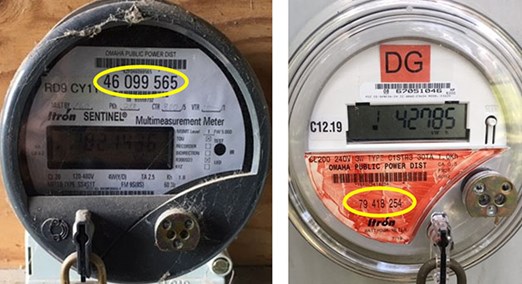
What is needed to add net metering to a commercial customer?
Typically, an additional meter and meter socket will need to be installed for commercial customers to participate in net metering. The specific details of the installation depends on the type of existing metering as discussed below. In either case, the customer and contractor need to decide where to mount the additional meter socket. Install meters and sockets in accordance with the OPPD Meter Specification Manual.
- Self-Contained Meters – OPPD will provide the net meter but the customer must provide the net meter socket. Install the net meter socket as close to the existing meter socket as is reasonable. Wire the sockets as shown below.
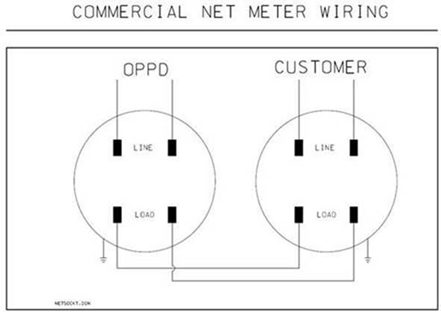
- CT Meters – OPPD will provide the net meter and meter socket. Call 531-226-5969 to arrange a time to pick up a socket from the OPPD Meter Shop. Install the net meter socket as close to the existing meter socket as is reasonable.
What does a sample site plan look like?
What does a sample one-line diagram look like?
Click image to expand
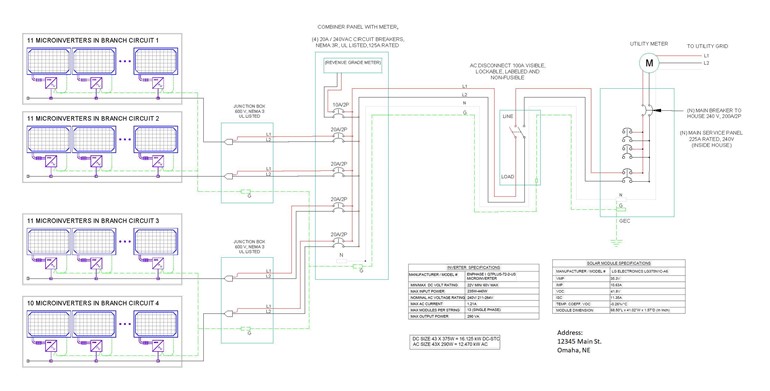
What does a sample meter placard look like?
What is the process for expanding on an existing solar system?
Contact OPPD anytime! We’re your energy partner and we’re here for you.
If you have questions about how to reduce your carbon footprint and save on utility bills with customer-owned generation, email productsandservices@oppd.com or call 1-877-536-4131. OPPD provides free consultation to ensure you’re on the right path to a successful generation purchase and installation. For business customers, email businesscustomerservice@oppd.com or contact your Account Manager or Senior Account Manager for more information.







